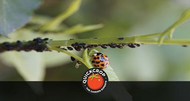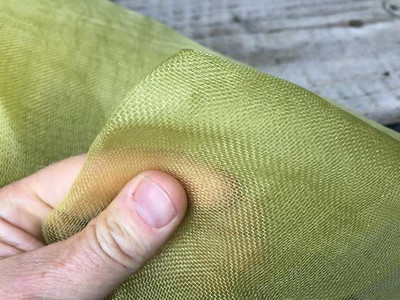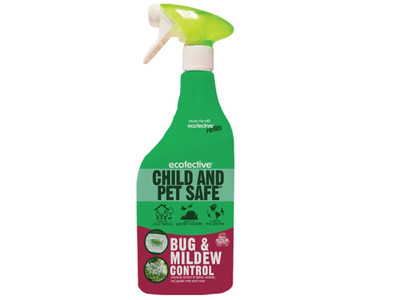Aphid Pest Control

Aphids are the source of much frustration in the garden. Also referred to as greenfly or blackfly, these small sap-sucking insects feed on ornamental plants and edibles alike. They can cause a range of damage including:
- yellow or curling leaves
- distorted foliage
- Weak or stunted growth
- transferring viruses from plant to plant
- They leave behind a sticky substance called honeydew, which in turn can cause the growth of black mould on the plant surface

Aphids are most active in spring and summer, commonly overwintering as eggs. They are partial to new growth and are often found on the underside of leaves or buds. What adds to their threat level is how fast an infestation can multiply. They skip the whole ‘needing a mate’ part of reproducing and instead the females essentially clone themselves. They can also be a particularly challenging problem when they populate on indoor plants, due to the lack of natural outdoor predators.

Micromesh Pest and Wind Barrier
View ProductWhile all of the above is certainly painting the aphid in a bad light, they do play their part in a healthy ecosystem. They provide food for beneficial predators (more on that below), and a certain level of aphid activity should be tolerated. In general, the beneficial insects that prey on aphids tend to arrive just a little later in the year, so aphid activity can build up in the garden in early spring before nature takes them down a peg or two. It’s good not to reach straight for your metaphorical flamethrower when you see aphids in your garden or vegetable beds: as we’ll see, methods of tackling them can (a) be a lot of work and (b) do wider harm. A reasonable population of aphids can be seen as encouraging natural predators to visit your garden, with all the attendant benefits.

Natural Aphid Predators
The natural world has a tendency to balance itself out, and so it is that the aphid’s impressive reproductive rate is offset by the number of garden predators that it has to cope with. You can encourage these beneficial insects with certain plant varieties or by providing suitable garden habitats such as log piles and sheltered areas.
- Hoverflies: These guys look a little bit like wasps, and play an important pollinating role in the garden. Hoverfly larvae feed voraciously on aphids, using their hook-like mouthparts to pierce them and inject digestive enzymes. As a bonus, hoverfly larvae are known to recycle organic matter in the garden. You can attract hoverflies with plants like achillea, alyssum and dill.
- Ladybirds: Both the adults and the larvae will feed on aphids. They will lay their eggs among aphid colonies for easy access. A single ladybird can eat as many as 5,000 aphids in their lifetime! Ladybirds are such an effective control that they can often be bought commercially as a ‘biological control’, but it’s always better to encourage them into your garden naturally. You can do this with plants such as marigolds, calendula or coriander. They also like to hibernate in indoor structures such as sheds, or among fallen leaves and wood. A ‘bug barn’ or insect hotel is another option.
- Parasitic Wasps: Parasitic wasps - such as the Sabre Wasp - will take care of aphids in a pretty gruesome manner. They lay their eggs inside or on the aphid, and as they hatch the larvae will feed on the living host. As this happens the aphid will become more bloated in appearance, before the young wasp cuts its way out. The swollen brownish or black exoskeletons left behind are known as ‘Aphid mummies’ (if you’re already thinking about Halloween costume ideas). I’m simply never going to write about parasitic wasps without mentioning that they inspired Dan O’Bannon’s vision of the xenomorph life cycle in Alien. He quoted the following from Carl Zimmer: “when an alien bursts out of a movie actor’s chest … it is nature itself that is bursting through, and it terrifies us”. Some of the best ways of attracting these monsters to your garden include a diverse range of nectar-producing plants, borders with plants such as yarrow, fennel or dill, shallow water sources and, of course, some hosts for them (which illustrates why a certain amount of aphids in the garden isn’t automatically a bad thing).
- Birds: Many bird species are partial to aphids, particularly when they need to feed their young. Sparrows and blue tits in particular have been known to pick plants clean of aphids. Bird boxes, feeding stations, berry-producing shrubs and brush piles are some surefire methods for attracting birds to your outdoor space.
Related Article: How to Attract Beneficial Insects to Your Garden
Water
Using a makeshift ‘jet stream’ of soapy water (or just plain water) can be a surprisingly effective method of dealing with aphids, but it’s something that you’ll likely need to keep doing daily for a period of 2 weeks or more to get on top of an infestation. You can use a hose, a lance spray or a spray bottle. Soapy water is much preferable to detergent or insecticidal soap etc, which can damage your plants or make them more vulnerable. Make sure to turn over leaves so you get at all the aphids.

Hand Removal
Yes, perhaps the simplest method of all - but again, this can be enough to keep a modest infestation under control. Pick the aphids off the plant using your thumb and forefinger and squash them. Repeat your inspection daily for at least a few days. Aphids can be tough to spot at times because they tend to hide themselves away in leaf joints or on the underside of leaves.
Mesh
Mesh netting can be placed over the plants you want to protect. For aphids (as well as insects such as flea beetles and carrot root flies), you will need to go for extra fine mesh or micromesh. The material will still allow air, sunlight and moisture in. The mesh can be placed over a frame such as a mini polytunnel, but you can also use it without a supporting frame and place it directly over the plant. However, it's beneficial to allow room for growth and not 'cramp' the plant. Fine mesh can increase humidity levels underneath the covering.

Micromesh Bulk Roll 1.8m
View ProductTrap Crops or Companion Planting
Planting nasturtiums is a popular technique with gardeners. This doesn’t so much repel aphids as act as a ‘bait’ or trap crop that attracts them away from your edible crops. Of course, technically this could also attract aphids to the area, but if you already have an active population then it could be a worthwhile technique. Sunflowers are another option that can be used to lure aphids away.
In terms of crops that are said to repel aphids, you can try garlic, dill or chives. Results can vary with deterrent crops, and it’s something that can be a cure or a complete waste of time depending on who you ask! In terms of aphid control, it might be better to focus on plants that attract natural aphid predators rather than hoping that a particular plant variety can vanquish the aphids altogether.

Companion plant - Climbing nasturtium
View ProductBiological Controls
For a bad aphid infection, you might find yourself in need of an urgent short-term solution. Biological controls refer to commercially-bought nematodes or predators which can be immediately applied to deal with an infestation. While it's preferable to attract beneficial insects naturally, biological controls can sometimes be necessary: especially when growing plants indoors or in a greenhouse, due to the lack of outdoor predators.

Ants
Another thing to watch out for when it comes to aphid control is the presence of ants. In a clever move, ants are known to ‘farm’ aphids for the honeydew that they create. They will actually protect the aphids and drive aphid predators away. Therefore if you see ants climbing up and down plant stems this can often be an indicator of a nearby aphid colony.
Pest Control Sprays
Be conscious of what sprays you use to tackle insects; chemical or synthetic pesticides are non-discriminating and can do harm to beneficial insects, bees and butterflies or even children and pets. Less harmful alternatives include what are known as 'plant invigorator' sprays. These work by a physical mode of action that discourages pests, as well as providing plants with nutrients. Ecofective for example contains a blend of surfactants that stop aphids and other insects from moving and being able to feed. Garlic barrier sprays are also an option; they are thought to work by masking the natural scent of the plant and deterring pests such as aphids. These are not 'magic bullet' sprays, nor they should be - if something gets rid of all your garden enemies overnight it's probably not a very healthy product! Regular re-application may well be necessary as well as combining with other methods mentioned such as hand removal.

Ecofective Bug & Mildew Control 1 Litre
View Product



